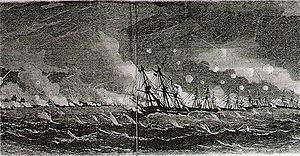Decommissioned 23 September 1865 Launched 5 October 1853 Displacement 2.835 million kg | Namesake Euryalus Fate Broken up, 1867 Length 212 ft (65 m) o/a Weight 3,175 tons Tons burthen 2.151 million kg | |
 | ||
HMS Euryalus was a fourth-rate wooden-hulled screw frigate of the Royal Navy, with a 400HP steam engine that could make over 12 knots. She was launched at Chatham in 1853, was 212 feet long, displaced 3125 tons and had a complement of 515 (this varied slightly as the Naval Standards varied). At the time of the Bombardment of Kagoshima she carried 35 guns, not counting approximately 16 carronades. Seventeen of her guns were breech-loading Armstrong Guns. She carried 230 tons of coal, and provisions for about three months, together with over 70 tons of shot and shell.
Contents
Service history
In December 1853 G. Ramsay was appointed captain, and the ship served in the Baltic Campaign in 1854-1855. Under the command of J.W. Tarleton, she served in the Mediterranean in 1858. The same year Prince Alfred was appointed to the ship as a midshipman and in 1860 the ship visited the Cape of Good Hope.
Euryalus arrived at Yokohama on 15 September 1862, the day following the Namamugi Incident, a samurai assault on British nationals on the outskirts of the treaty port that led to a major breakdown in Anglo-Japanese relations. In an effort to enforce reparations from the Satsuma Domain, Euryalus served as Admiral Sir Augustus Kuper's flagship during the bombardment of Kagoshima on 16 August 1863. During the bombardment of Kagoshima the Captain of Euryalus, John James Steven Josling, was killed, as was his second-in-command, Commander Edward Wilmot, both decapitated by the same cannonball. Eight other members of the crew also died in the action, their names all commemorated on a memorial in the former British Consulate building in Yokohama.
Euryalus also participated in the bombardment of Shimonoseki in September 1864. The captain and commander of the ship at Shimonoseki was Captain John Hobhouse Inglis Alexander, who was severely wounded in the ankle as he led the assault on the batteries onshore. It was at Shimonoseki that Duncan Gordon Boyes won his Victoria Cross at the remarkably young age of 17.
Fate
Euryalus was paid off at Portsmouth on 23 September 1865. She was broken up in 1867.
